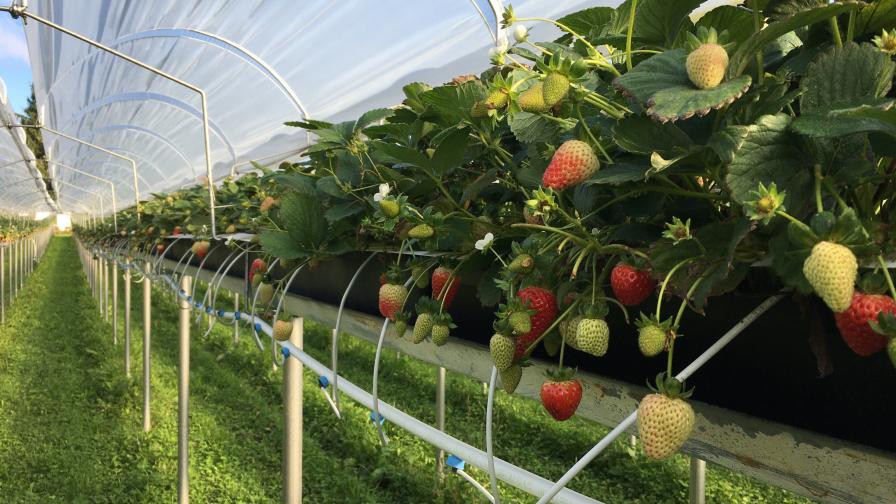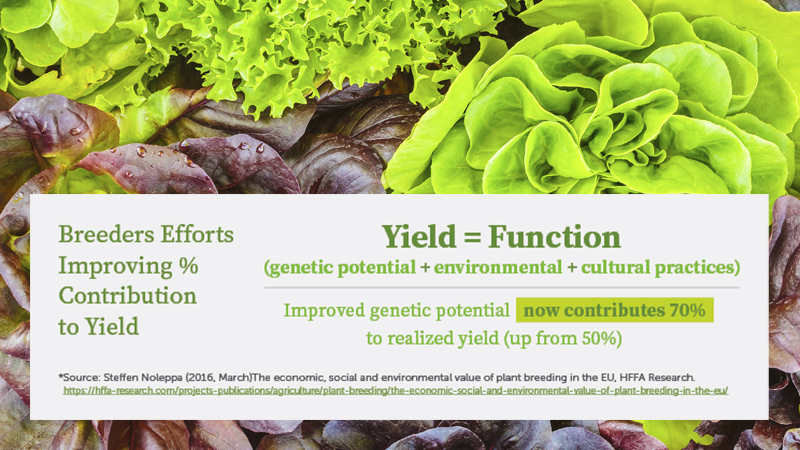Why Growing Strawberries Without Soil Is Gaining Ground

These tabletop strawberries are being grown in a soilless media. There are advantages for growers to this production method.
Photo courtesy of Ontario Ministry of Agriculture, Food, and Rural Affairs
What works for growers in Ontario, Canada, often works for growers in the Northeast U.S., and currently one of the hot topics on both cold-climate sides of the border is soilless production systems for strawberries.
“There’s been an increasing interest in the last few years,” Erica Pate, a Fruit Crop Specialist with the Ontario Ministry of Agriculture, Food, and Rural Affairs (OMAFRA), told attendees of the New England Vegetable and Fruit Conference.
Multiple reasons account for the popularity of soilless systems, according to Pate:
Soil disease prevention: Bringing berries out of the soil means a grower doesn’t have to rotate crops, she says. “You can produce berries where there is poor soil quality and reduce soilborne diseases and the need to fumigate.”
Improved labor conditions and efficiency: Most soilless strawberry systems are raised off the ground, about 5 feet high, Pate says. “As labor continues to become a bigger challenge, these raised systems are more attractive to workers and more efficient because workers are picking at a more comfortable height. One comment from a grower in Ontario is that their workers can pick all day rather than just a few hours in the morning.”
Increased system control: Growers have more control over fertilizer and irrigation. “If it’s in a protected system or a covered system, you can keep the rain off the berries, helping with disease management, fruit quality, and harvest consistency.”
Season extension: High tunnels, mini tunnels, and other protected systems provide a longer growing season.
Most soilless strawberry systems in Ontario grow day-neutral varieties, largely ‘Albion’ and ‘San Andreas’, Pate says. They are being planted as soon as possible in the spring, typically in early April or possibly late March if they have the labor, she adds. Typical density is six to nine plants per meter or two plants per foot. Substrate options include coir, peat, and perlite.
Close attention to irrigation and fertigation is necessary, Pate says, as the plants are getting all their nutrients through fertigation. “Irrigation fluctuates every day,” she says. “It can go from five to 20 times a day, depending on the conditions.”
Once harvest begins, growers can pick regularly every two days, Pate says.
From the Ground Up
After deciding to grow strawberries in a substrate, growers enjoy several options for systems. The choice varies for each operation and depends on the grower, his or her preference over level of control, and size of the operation and market.
Ground-level setups illustrate that soilless systems do not have to be high tech. Ground gutters are shaped with the soil and covered with plastic or fabric, which helps with weed control and prevents the roots in the substrate from growing into the soil. The systems can be covered with a high tunnel or placed in an open field.
“This is the easiest system with the lowest investment. And aside from being the cheapest system, this system also helps with earlier production,” Pate says. “The big disadvantage is that you’re still growing on that ground level. Growers aren’t enjoying the improved labor conditions and picking efficiency.”
Tabletop systems include supports for gutters that are raised about 5 feet off the ground. The berries are grown in substrate bags on top of the gutters. In this open-air system, growers have fewer infrastructure costs compared to protective culture but also less control over the environment, so there’s more disease pressure and potentially lower fruit quality.
“This open system with no cover is cheaper, but the general consensus is that if you’re investing in bringing your plants out of the ground and raising them up, you should invest in covering them,” Pate says. “Once you move to this type of system, where you’re raising the plants up, you have to adapt your equipment. You might need different machinery to drive up and down the rows for spraying and need to manage the grass around the gutters.”
All substrate systems are supplied with water and nutrients through trickle irrigation, with two or four emitters per bag. Bags are 3 feet long.
Protected Systems
In Europe, where berries have been grown in substrate for decades, about 95% of substrate-grown strawberries are in protected systems, Pate says. Most of the systems she sees in Ontario are either in high tunnels or mini tunnels.
“Tunnels or other shelters protect your crop from wind and rain,” she says, “so you have no loss from rain damage on the fruit, less disease pressure, more control over irrigation, and you can harvest every day, even when it’s raining. And you don’t have to wait for the berries to dry off or worry about working in the field when it’s wet, resulting in more consistent and predictable harvest schedules.”
With regard to season extension, “one grower I was speaking with starts harvest in early June and continues right until October,” Pate says.
High tunnels consist of about six rows in each bay, spaced about 6 feet apart. Berries are grown in pots, troughs, or bags placed in steel gutters that are supported by posts. Ground management options include landscape fabric and sod.
Venting remains a labor challenge with plastic-covered high tunnels. In the spring growers need to first install the plastic and then, to manage heat, open and close the ends of the tunnels, and raise up and down the sides. In the summer, when the tunnels can turn hot, extra labor is needed to vent the sides of the tunnels.
With mini tunnels, only one row is covered at a time, meaning berries are protected but workers are not. This protection keeps berries dry while boasting the same benefits as high tunnels. The system does require more labor per certain tasks, Pate says, although venting is less of an issue.
Pate says growers may be interested in Meteor Systems, a Dutch company that manufactures Mini Air systems. Unlike high tunnels and mini tunnels, in which gutters are supported on tabletops, they are suspended from structures, so there are fewer posts on the ground beneath every row.
“It’s a little bit easier to drive around with fewer posts,” she says. “You have a little bit more space for managing the grass or for any of your harvesting or other equipment.”
The Mini Air systems also provide rainwater collection, which is a benefit, Pate says. And, depending on which system a grower purchases, ventilation can be controlled manually or automatically.
Mini air light systems are similar to mini air systems, although they do not offer rainwater collection, and their ventilation systems cannot be controlled.
Meanwhile, growers who want more control will grow strawberries in a greenhouse, according to Pate. These systems include indoor heating and lights for offseason production, so growers are growing strawberries all winter long.
“Our greenhouse industry is also growing in Ontario,” Pate says.










